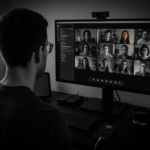
Filed under: Observations in Focus
The screen was a gallery of blank stares.
Twelve squares. Eleven muted. One talking.
The voice droned on about cross-functional alignment. No one blinked.
Except for her.
“You seeing this?”
A Slack message popped up on my second screen. It was from Mira.
She and I had been teammates long enough to know the rhythms of these meetings—mostly dead air, occasionally punctuated by passive-aggressive optimism.
“Look at Sarah’s eyes,” she typed.
“That’s not just disengagement. That’s strategy.”
What the Eyes Give Away
Sarah, upper-right Zoom box.
First, she glanced down. Not to check notes. A reset. A centering.
Then a flick left—memory retrieval.
Up and right next—constructing a response she’d never voice.
Then came the forehead press. Index finger to temple. A micro-second of pressure.
“That’s the bridge,” Mira messaged. “Between what she wants to say and what she’ll actually say—if anything.”
She didn’t speak.
But she didn’t need to. The gaze said enough.
What Mira Saw That I Missed
She’d been doing this for months—maybe years.
Watching, cataloging, training herself to read meetings like metadata.
“Most people watch slides,” she once told me. “I watch the pauses. The fidgets. The gaze aversions. That’s where the truth lives.”
While others tuned out, she tuned in.
She tracked blinking patterns the way others tracked KPIs.
She noticed when someone’s camera stayed on but their mind left the room.
A glance up mid-sentence. A slight squint. A too-quick nod.
“None of it’s random. You just have to watch long enough to see the patterns form.”
🎯 This Is an Opportunity to Practice Pattern Recognition
Most meetings aren’t draining because of the content.
They’re draining because there’s no meaning, and your brain knows it.
So give it some.
When the discussion slides into the void, shift your focus—not to multitasking, but to observation.
Start watching for what’s not on the slide.
Start reading the interface of the room.
- Who blinks less as the stakes go up?
- Who looks down every time they’re interrupted?
- Who subtly shifts posture just before offering a dissenting view?
This is live training.
This is field research.
This is your chance to sharpen the edge most people let dull:
pattern recognition.
You’re not zoning out. You’re zoning in.
You’re staying present, not by force—but by focus.
🕵️ Observation as Practice
The meeting continued. No decisions made. Just airtime filled.
But Mira had already taken notes—none of which were about the agenda.
“You don’t need to leave a meeting with deliverables to have made progress,” she wrote.
“You just need to leave with a better eye.”
That stuck with me.
So now I watch.
Not to judge. Not to zone out.
But to train.
Meetings like this aren’t the enemy. They’re training grounds for minds like yours.
So next time you’re invited to something pointless, ask yourself:
“What’s the invisible skill I can sharpen here?”
And then—practice.
Because the truth is, most people spend meetings trying to escape.
But the ones worth watching?
They’re the ones using the time to evolve.
🔍 The Mental Reframe
Meetings rarely teach us what they claim to. But they can teach us something.
“What is this an opportunity to practice?”
For me? It’s pattern recognition.
Cognitive load. Micro-gestures.
It’s staying sharp when the room goes soft.
Observation not as escape.
But as evolution.
Filed under: Pattern Recognition – Case 049
Subject: Behavioral Leakage in Professional Environments
This investigation is part of The Deductionists—a league of sharp minds dissecting the hidden systems and behavioral patterns of modern work. Because if we don’t question it, who will?
🎙 Hear more irreverent insights on The Deductionists Podcast—available on Spotify, Apple Podcasts, and anywhere you get your podcasts.
🔗 Listen now:
👉 Apple Podcasts
👉 Spotify
Subscribe to the Newsletter on LinkedIn: The Deductionists Newsletter.